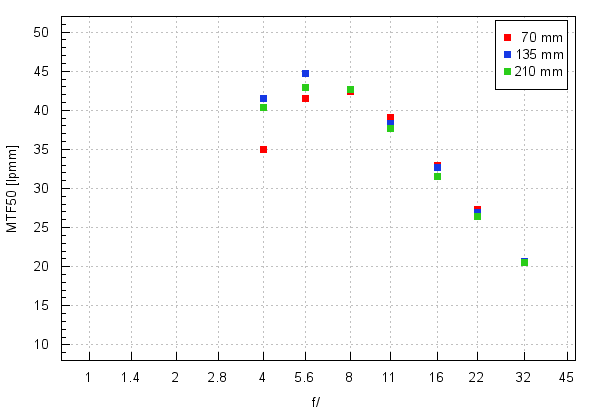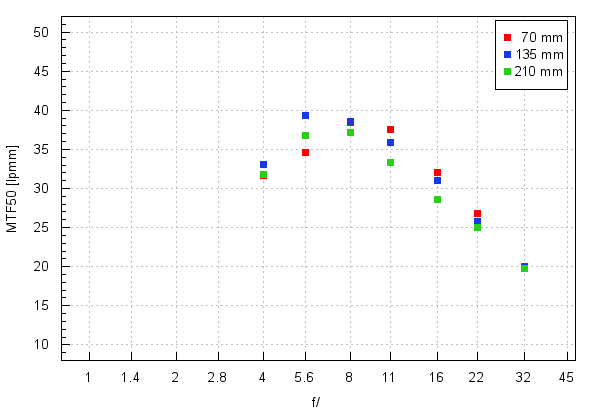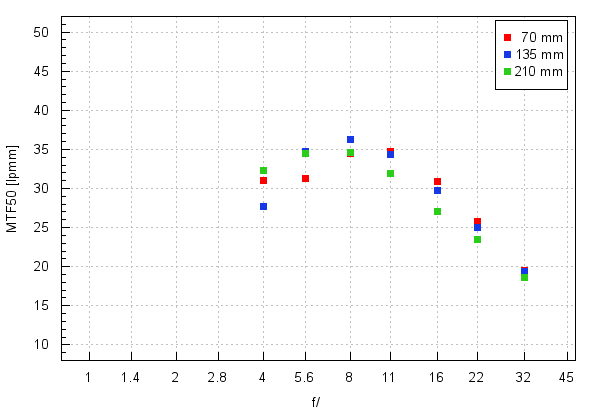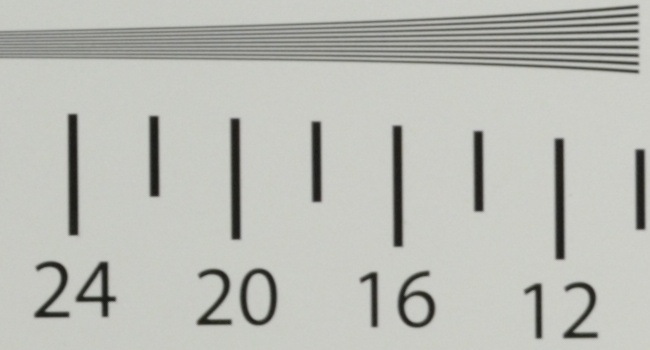Tamron 70-210 mm f/4 Di VC USD
4. Image resolution
Let’s check how the tested lens compares – a graph below presents its results in the frame centre at 70, 135, and 210 mm focal lengths.

Please Support UsIf you enjoy our reviews and articles, and you want us to continue our work please, support our website by donating through PayPal. The funds are going to be used for paying our editorial team, renting servers, and equipping our testing studio; only that way we will be able to continue providing you interesting content for free. |
- - - - - - - - - - - - - - - - - - - - - - - - - - - - - - - - - - - - - - - - - - - - - - - -
The 135 mm focal length fares the best and you should call it only excellent. Already at the maximum relative aperture the results exceed 40 lpmm and on stopping down they reach even 45 lpmm. 120 mm offers you a just slightly worse performance, with maximum MTFs getting to 43 lpmm but at the maximum relative aperture the lens is still able to exceed a very high level of 40 lpmm.
After observing the performance at 70 mm it is clear the tested Tamron was optimized for longer focal lengths; still it doesn’t mean at 70 mm you experience any problems. At the maximum relative aperture the results reach a very sensible level of 35 lpmm and on stopping down they distinctly exceed 40 lpmm.
A similar optimization was employed in the Canon EF 70–200 mm f/4L IS USM, where the 70 mm focal length was actually the weakest. However, the results of the Canon were overall a tad worse across the focal range than the result of the Tamron, tested here. The Nikkor AF-S 70–200 mm f/4.0G ED VR for a change performed the best from 70 to 135 mm, with a crisis at the 200 mm. The Tokina AT-X PRO FX SD 70–200 f/4 VCM-S showed practically identical results at all focal lengths but it was able to exceed 40 lpmm only near f/8.0.
To sum up: in the frame centre the Tamron presents the best performance of all lenses, described above and the widest focal range is its additional asset. Well done!
Now let’s check the results on the edge of the smaller APS-C/DX sensor.

The 135 mm focal length still fares the best but the results of the rest of the range are more evened out. There are no weak points anywhere, with MTFs reaching near 32-33 lpmm at the maximum relative aperture getting to 40 lpmm on stopping down.
No other lens in the group of rival devices fares better than the Tamron here. The Nikkor fared similarly well and the Canon and the Tokina were a bit weaker.
Now let’s check how the situation changes when you pass to a very demanding edge of full frame detector.

The fact that the 135 mm is actually the weakest comes as a surprise – so far at that point the lens fared the best. Unfortunately here the combination of f/4.0 and 135 mm can be only described as weak but the situation improves swiftly on stopping down and near f/8.0 the 135 mm returns to its previous performance and dominates. Mind you, the values at 70 and 210 mm can hardly be criticized; they remain decent even by f/4.0.
Overall the tested lens should be only praised. One slight slip-up at 135 mm and by f/4.0 on the very edge of full frame cannot change our positive opinion because the rivals had their weak points too and they were often far more painful. In this group of lenses the Tamron seems to win although we have to admit its duel with the Nikkor was sometimes too close to call.
At the end, traditionally, we present crops taken from photos of our resolution testing chart saved as JPEG files.
| NikonáD3x, JPEG, 70ámm, f/4.0 |
 |
| NikonáD3x, JPEG, 135ámm, f/5.6 |
 |






